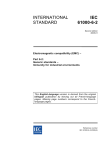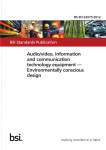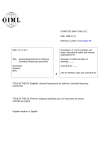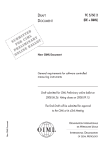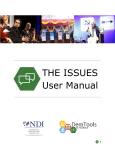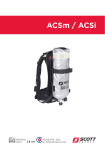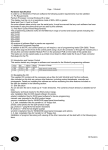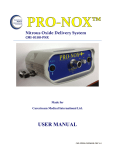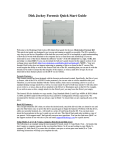Download IECQ COMPONENT SPECIFICATION
Transcript
IECQ CS 033000-UK0001 Edition 1.0 2015-10 IECQ COMPONENT SPECIFICATION IEC Quality Assessment System for Electronic Components (IECQ System) IECQ CS 033000-UK0001:2015-10(en) E-Labelling – Specifications for writing and reading THIS PUBLICATION IS COPYRIGHT PROTECTED Copyright © 2015 IEC, Geneva, Switzerland All rights reserved. Unless otherwise specified, no part of this publication may be reproduced or utilized in any form or by any means, electronic or mechanical, including photocopying and microfilm, without permission in writing from either IEC or IEC's member National Committee in the country of the requester. If you have any questions about IEC copyright or have an enquiry about obtaining additional rights to this publication, please contact the address below or your local IEC member National Committee for further information. IEC Central Office 3, rue de Varembé CH-1211 Geneva 20 Switzerland Tel.: +41 22 919 02 11 Fax: +41 22 919 03 00 [email protected] www.iec.ch About the IEC The International Electrotechnical Commission (IEC) is the leading global organization that prepares and publishes International Standards for all electrical, electronic and related technologies. About IEC publications The technical content of IEC publications is kept under constant review by the IEC. Please make sure that you have the latest edition, a corrigenda or an amendment might have been published. IEC Catalogue - webstore.iec.ch/catalogue The stand-alone application for consulting the entire bibliographical information on IEC International Standards, Technical Specifications, Technical Reports and other documents. Available for PC, Mac OS, Android Tablets and iPad. Electropedia - www.electropedia.org The world's leading online dictionary of electronic and electrical terms containing more than 30 000 terms and definitions in English and French, with equivalent terms in 14 additional languages. Also known as the International Electrotechnical Vocabulary (IEV) online. IEC publications search - www.iec.ch/searchpub The advanced search enables to find IEC publications by a variety of criteria (reference number, text, technical committee,…). It also gives information on projects, replaced and withdrawn publications. IEC Glossary - std.iec.ch/glossary More than 55 000 electrotechnical terminology entries in English and French extracted from the Terms and Definitions clause of IEC publications issued since 2002. Some entries have been collected from earlier publications of IEC TC 37, 77, 86 and CISPR. IEC Just Published - webstore.iec.ch/justpublished Stay up to date on all new IEC publications. Just Published details all new publications released. Available online and also once a month by email. IEC Customer Service Centre - webstore.iec.ch/csc If you wish to give us your feedback on this publication or need further assistance, please contact the Customer Service Centre: [email protected]. IECQ CS 033000-UK0001 Edition 1.0 2015-10 IECQ COMPONENT SPECIFICATION IEC Quality Assessment System for Electronic Components (IECQ System) E-Labelling – Specifications for writing and reading INTERNATIONAL ELECTROTECHNICAL COMMISSION PRICE CODE ZZ –2– IECQ CS 033000-UK0001 © IEC 2015 FOREWORD The IEC Quality Assessment System for Electronic Components (IECQ) is composed of those member countries of the International Electrotechnical Commission (IEC) who wish to take part in a harmonized system for electronic components of assessment quality. IECQ is also formally known in some European member countries as IECQ-CECC. The object of the System is to facilitate international trade via business to business supply chain management tools and the harmonization of the specifications and quality assessment procedures for electronic components, assemblies and related materials and processes, and by the grant of an international recognized Certification of Conformity and the optional use of an IECQ Mark of Conformity. The components produced or services provided under the System are therefore accepted in all member countries without further testing. This Component Specification is based upon the requirements of IECQ 03 Series of Rules of Procedure by: ECC Corp. 839 N Rochester Road Clawson Michigan USA and published under the authority of: BSI Kitemark Court, Davy Avenue Knowlhill, Milton Keynes MK5 8PP United Kingdom AMENDMENT RECORD No previous editions. REQUIREMENTS The following data sheet satisfies the requirements of IECQ Component Specifications as detailed in IECQ 03 Series of Rules of Procedure. It should be note that IECQ is not responsible for manufactures declaration made in data sheets which fall outside the limits of Certificates of Conformity. IECQ CS 033000-UK0001 © IEC 2015 –3– Component Specification number: Component Specification available from: ☒ Publicly available Specifications − IECQ Certification Body under whose authority the Component Specification (CS) is published − IEC Webstore − IECQ Website www.iecq.org/publications/specifications / ☐ Proprietary Specifications − IECQ Certification Body under whose authority the Component Specification (CS) is published − Other: … Electronic Components of Assessed Quality Component Specification in according with: ISO/IEC 15415, Information technology – Automatic identification and data capture techniques – Bar code symbol print quality test specification – Twodimensional symbols IECQ CS 033000-UK0001 for use within the IECQ Approved Component Scheme Edition: 1.0 IECQ Certification Body: BSI Kitemark Court, Davy Avenue Knowlhill, Milton Keynes MK5 8PP United Kingdom Product description: E-Labelling, that may be affixed to, or laser marked into the surface of electronic devices and components. ISO/IEC TR 29158, Information technology – Automatic identification and data capture techniques – Direct Part Marking (DPM) Quality Guideline Outline drawing and install information: Applicant: ECC Corp. 839 N Rochester Road Clawson Michigan USA Guidelines − Component Specification available from: The Category of Component Specification “Public” or “Proprietary”, other sources of availability maybe be listed under “Proprietary” if applicable. In accordance with IECQ OD 302, Clause 5.6. − IECQ Certification Body: The name of the IECQ Certification Body under whose authority the Component Specification is published. − Component Specification Number: The unique identification number allocated by the IECQ CB in accordance with IECQ OD 302, Clause 5.3 “Numbering”, and Edition status. − Electronic Components of Assessed Quality Component Specification in according with: The list of standards and or specifications that are utilized within the Component Specification where relevant, these maybe IEC or IECQ or ISO International Standard, or generic (and, if appropriate, sectional) specifications or a Technology Approval Schedule (TAS) relevant to the CS or where in the absence of an IEC, IECQ or ISO International Standard a national and or industry recognized standard/specification. − Product description: A brief description of the approved components, piece parts or material. − Outline drawing and install information: An outline drawing with main dimensions that are of importance for interchangeability and applicable installation information. − Applicant: The creator of the Component Specification. –4– IECQ CS 033000-UK0001 © IEC 2015 E-Labelling – Specifications for writing and reading 1 Introduction The E-Labelling functionality is based on AIDC (Automatic Identification and Data Capture) Information Technology. AIDC is normally referred to as Bar Coding. The technology of Bar Coding is based on the recognition of patterns encoded, in bars and spaces or in a matrix of modules of defined dimensions. These are fixed according to rules defining the translation of characters into such patterns, known as the symbology specification. Symbology specifications may be categorized into those for linear symbols, on the one hand, and twodimensional (2-D) symbols on the other (ISO/IEC 15415). An AIDC symbol must be produced in such a way as to be reliably decoded at the point of use, if it is to fulfil its basic objective as a machine-readable data carrier. E-Labelling Information Technology is based on a unique symbology. As a single mark (“Mark’), it has application for external marking on electrical or electronic devices (“Device”) for regulatory compliance where there is insufficient available space to locate multiple marks. It can be produced as an Affixed Printed Product (APP) that is applied to the Device or Direct Part Marking (DPM) typically laser etched into the outer surface of the Device. In both cases the area of the alteration to the substrate/device is called the “Mark”. The area that includes the Mark and background as a whole, when containing a pattern defined by a 2-D symbology specification, is called a “Symbol”. Individual electronic components are considered Devices. With traditional 2-D symbologies, the Mark is always smaller than the Symbol. This is because of the requirement for a so-called “quiet zone” surrounding the Mark. The technology used for E-Labelling has no such limitation, and the Mark is normally the same size as the Symbol. This feature is critical for devices where free space is restricted. For E-Labelling, therefore, the terms Symbol and Mark are interchangeable and synonymous. For clarity in this specification it is called Mark. Direct Part Marking (DPM) is a technology whereby, generally an item is physically altered to produce two different surface conditions. This alteration can be accomplished by various means including, but not limited to, laser etching. Low cost, low power fiber lasers are normally used. The Mark is typically 50-100 Microns deep and does not damage the device. For E-Labelling DPM applications, this specification is based on ISO/IEC TR 29158. For both E-Labelling formats, APP and DPM, the encoded Mark requires light to read and decode. The data elements within the Mark are identified using a technology known as Optical Character Recognition (OCR). When light illuminates the Mark, it reflects differently depending on whether it impinges on the background of the substrate or on the physical alteration. For APP E-Labelling, when scanning to decode, light is reflected off a smooth surface that has been colored to produce two different diffuse reflected states. The DPM environment generally does not fit this model because the two different reflected states depend on at least one of the states having material oriented to the lighting such that the angle of incidence is equal to the angle of reflection. However the E-Labelling DPM technology has overcome this limitation. There are many methods of assessing 2-D symbology quality at different stages of Symbol production. The methodologies described in this document are not intended as a replacement for any current process control methods. They provide Mark producers and their trading partners with universally standardized means for communicating about the quality of the ELabelling formats. The procedures described in this Component Specification must necessarily be augmented by the reference decode algorithm and other measurement details within the E-Labelling Mark specification, and they may also be altered or overridden as appropriate by governing symbology or application specifications. IECQ CS 033000-UK0001 © IEC 2015 2 –5– Scope This is an engineering document intended for application specifications developers. It describes modifications which are to be considered in conjunction with the Mark quality methodology defined in ISO/IEC 15415 and ISO/IEC TR 29158 and a symbology specification. It defines alternative illumination conditions, some new terms and parameters, modifications to the measurement and grading of certain parameters, and the reporting of the grading results. It was developed to assess the Mark quality of both Affixed Printed Product (APP) and Direct Part Marking (DPM) of E-Labelling products, where the Mark is either printed on an affixable material substrate to be applied directly to the surface of the Device or where the Mark is laser etched directly into the outer surface of the Device. In both cases the reading equipment can be a Smartphone or, webcam attached to a PC. For accurately measuring and grading the quality of the Mark, a microscope camera is required, with minimum requirement of 1.2 mega pixels, 200x magnification and 6 co-axial LED lights. This method is appropriate and can be equally applied to Marks produced to APP and DPM methods. Marks are being scanned in the same scanning environment. 2.1 Application This specification defines the requirements to establish and control the production of IECQ Approved Component – E-Labelling that may be affixed to, or etched into, the surface of electronic devices. In these instances the E-Labelling specification only applies after data records (“Data Records”) specific to the Device have been digitally linked to that Device. The E-Labelling Data Record may include: specifications, images, text, drawings, photographs, videos etc. In the event affixable label material is produced away from the Device manufacturing location, the requirements for verifying both the print and read quality of the label is defined in ISO/IEC 15415, ISO/IEC 19762-1 and ISO/IEC 19762-2. In the event that E-Labelling is produced, this specification defines the requirements for implementing processes to first print or mark the E-Labelling then test, analyze or otherwise ascertain the ability of the E-Labelling to be correctly read and then to successfully test, analyze and link to the associate Data Records and make these Data Records available in an efficient manner to the customer or agency. Data Records linked to the E-Labelling, provide compliance with the regulatory information that is otherwise impractical to reside on the external surface of the Device because the available space is too small or overcrowded. 3 Normative references The following publications contain provisions, which, through reference in this text, constitute provisions of this specification. At the time of publication, the editions indicated were valid. ISO/IEC TR 29158, Information technology – Automatic identification and data capture techniques – Direct Part Mark (DPM) Quality Guideline ISO/IEC 15415, Information technology – Automatic identification and data capture techniques – Bar code symbol print quality test specification – Two-dimensional symbols –6– IECQ CS 033000-UK0001 © IEC 2015 ISO/IEC 19762-1, Information technology – Automatic identification and data capture (AIDC) techniques – Harmonized vocabulary – Part 1: General terms relating to AIDC ISO/IEC 19762-2, Information technology – Automatic identification and data capture (AIDC) techniques – Harmonized vocabulary – Part 2: Optically readable media (ORM) In the event of conflict between the provisions of this document and any other directly or indirectly referenced provisions, the provisions of this document shall take precedence. 4 E-Labelling general description The Mark for E-Labelling is a matrix (see Figure 1) consisting of 17 horizontal rows and 17 columns. The overall size of the Mark is typically 12 x 12 mm square. From such an example Mark, the Matrix consists of Elemental Spaces which are 0.706 x 0.706 mm (12/17). Elemental Space Figure 1 Within each Elemental Space is an elemental readable character or Glyph. The Mark is made up of 289 Glyphs. The Glyph consists of the character similar to font “Y” with one vertical leg and two opposing arms. Starting in the top left hand corner of the Mark (Row 1, Column 1) the Glyph can be seen to be oriented in the normal way with the leg pointing down and the arms up. Using the analogy of a timepiece the letter Y points to 6 o’clock. Closer examination of the Mark (see Figure 2) shows that the majority of the Glyphs “clock” in 90 degree increments corresponding to the chimes of a Townhall clock (3, 6, 9, & 12). Exceptions to this can be seen Row 9 and Column 9. In these cases, none of the Glyphs point in the primary 90 degree orientations, but instead all at the same 45 degrees. The Glyphs in Row 9 and Column 9 are all identical and do not clock. They are designated Orientation Symbols. IECQ CS 033000-UK0001 © IEC 2015 –7– Figure 2 The remaining Glyphs are separated into four quadrants of 64 (8 x 8), for a total of 256 Glyphs. Although the orientations appear random they do in fact have a Quatnary equivalent of 0, 1, 2 & 3. Using Hexadecimal translation this schema provides for 5.19 X 10³³ unambiguously unique identifiers. 4.1 Reading the E-Labelling Mark Traditionally the measurement of the 2-D symbols is designed to yield a quality grade indicating the overall quality of the symbol which can be used by producers and users of the symbol for diagnostics and process control purposes, and which is broadly predictive of the read performance to be expected of the symbols through various environments. This process requires the measurements and grading of defined parameters, from which a grade for an individual scan is derived; the grades of multiple scans of the symbol are then averaged to provide the overall symbol grade. Many of these 2-D symbols have limitations related to certain key features which if damaged, missing or covered render the making unreadable (for example the edge finder pattern for Data Matrix or positioning blocks for QR Code). By way of a comparison the E-Labelling Mark requires only 2 out of 17 of each of the orientation Glyphs in Column 9 and Row 9 to be present. –8– 4.2 IECQ CS 033000-UK0001 © IEC 2015 Optical Character Recognition E-Labelling employs a search methodology for reading the Mark. It views the Mark using Optical Character Recognition (OCR) technology and employs the camera reticle as guidance to center the Mark. The finder process establishes the center of the image containing a Mark. It then begins a spiral search from the point outward looking for the Glyphs within the image. The decoder is parametrized to match the Mark to be decoded. The decoder parameters inform the decoder how many Glyphs constitute the Mark in the image capture steps facilitating the process. After the Mark has been located the image is then binarized into grey scale. The Algorithm searches for something to outline and identify as a Glyph by which areas inside the outline are “on” or “off”. After finding one symbol it looks for others left, right, up, and down from that one within a distance calculated from the size of the first one found. This can be characterized as a spiral search. The search does not go in any direction beyond than the maximum number of symbols across a Mark, i.e. 17. The final decoding is performed after image capture with OCR. The spiral search continues until either all the elements are found or there is sufficient clock cycles expended to be considered outside the mark space. Then the data is searched for the orientation of the finder pattern and the data elements (Glyphs) are adjusted for the Mark matrix. The Mark data is then sent to the server to complete the decoding process. Typically this is accomplished in less than 80 microseconds (0.08 seconds). 5 5.1 Terms and definitions IECQ Approved Component Scheme Scheme of the IECQ enabling the independent conformity assessment of an organization for compliance of Component Products, Related Materials, Devices and Assemblies with a defined specification within a given scope. 5.2 Axial Non-Uniformity Axial Non-Uniformity is the amount of deviation along the Mark’s major axes. This indicates that the marking or printing process is resulting in the Y-dimensions of individual modules being greater than their X-dimensions. For APP this inconsistency of X- and Y-dimensions typically indicates movement of the object as it is being marked. For DPM this normally indicates that the zone being etched is outside the recommended marking zone for the laser. 5.3 Mark Contrast Mark Contrast is the value difference between binarized light and dark elements. If the contrast between the dark elements (etched or printed) and the light elements (the substrate’s surface) are too close in value, this undermines readability. With APP this can normally be corrected by increased ink flow. 5.4 Element Contrast Element Contrast is the value difference between light and dark Glyph elements. This is critical for reading low-contrast DPM Marks. If the light and dark elements are too close in value, this undermines readability. This can normally be corrected by using an alternate illumination technique. 5.5 Decodability Decodability refers to a symbol’s ability to be decoded using the standard reference decode algorithm. IECQ CS 033000-UK0001 © IEC 2015 5.6 –9– Fixed Pattern Damage Fixed Pattern Damage refers to orientation Glyphs. Of the 17 vertical orientation Glyphs and 16 horizontal orientation Glyphs (the Glyph in Row 9 column 9 is not counted twice, see Figure 2) the OCR needs to find only two in the vertical array and one in the horizontal or vice versa to successfully orient the Mark. 5.7 Minimum Reflectance Minimum Reflectance refers to the minimum reflectance of light by the Mark’s light elements. The Mark’s light elements must exhibit a minimum reflectance to ensure contrast against the darker substrate and to allow readability. 5.8 Reflectance Margin Reflectance Margin measures how well each Glyph of the Mark is correctly distinguishable as light or dark in comparison to the global threshold. Low reflectance margin may increase the probability that a Mark element may be incorrectly identified as dark or light. 5.9 Error Correction The E-Labelling Mark contains 289 Mark Glyph. Of those 256 are actual Data Glyphs and 33 are Orientation Glyphs. The actual Data package is carried within 14 Glyphs, the balance of 242 are used for error detection and error correction. This provides for an error correction capacity of 94.5% 5.10 Unused Error Correction Unused Error Correction indicates the amount of available error correction in the Mark. Error correction is a method of reconstructing or replacing data that is lost through Mark damage. 100% unused error correction is ideal. 5.11 Print Growth For APP, Print Growth refers to the deviation (larger or smaller) of actual element size from intended element size due to printing problems. When a Mark is printed, the ink may “bleed” when it comes in contact with the substrate, causing an overprint. If there is not enough ink, or if there is some other problem with printing equipment, the result may be an underprint. 6 Abbreviated terms APP Affixed Printed Product DPM Direct Part Marking FPD Fixed Pattern Damage LED Light Emitting Diode OCR Optical Character Recognition 7 7.1 Illumination Illumination for DPM This specification recommends three specific lighting environments consisting of two forms of diffuse lighting (non-directional) using the format defined in ISO/IEC TR 29158: a) Diffuse on-axis illumination uses a diffuse light source illuminating the Mark nominally perpendicular to its surface (nominally parallel to the optical axis of the camera). – 10 – IECQ CS 033000-UK0001 © IEC 2015 b) Diffuse off-axis illumination uses light from an array of LEDs reflected from the inside of a diffusely reflecting surface of a hemisphere, with the Mark at its center, to provide even incident illumination from all directions. c) Directional illumination is oriented at a low angle (approximately 30 degrees) to the Mark surface. 7.2 Illumination for APP Two lighting environments each with sub-options are defined in this guideline: diffuse and low-angle. The defined lighting environments are denoted in the reported grade using the format defined in ISO/IEC 15415 using the angle specifier with a combination of numbers and letters as defined below. NOTE This does not limit the prerogative of an Application Specification to choose different lighting environments based on application requirements. Alternate lighting environments should include specifiers consistent with the format of those below which can be used for communicating quality requirements and quality grades. 7.2.1 Diffuse perpendicular (on-axis/bright field) (90) A flat diffusing material is oriented such that the plane of the material is parallel to the plane of the Mark area. The Mark is uniformly illuminated with diffuse light incident at 90 ± 15 degrees relative to the optical axis to the plane of the Mark. The angle specifier shall be 90 to denote this lighting environment. 7.2.2 Diffuse off-axis (D) A diffusely reflecting dome is illuminated from below so that the reflected light falls nondirectionally on the Device and does not cast defined shadows. This is commonly used for reading curved parts. The angle specifier shall be D. 7.2.3 Low angle, four directions (30Q) Light is aimed at the part at an angle of 30 ± 3 degrees from the plane of the surface of the Mark from four sides such that the lines describing the center of the beams from opposing pairs of lights are co-planar and the planes at right angles to each other. One lighting plane is aligned to be parallel to the line formed by a horizontal edge of the image sensor to within ± 5 degrees. The lighting shall illuminate the entire Mark area with uniform energy. The angle specifier shall be 30Q. 7.2.4 Low angle, two directions (30T) Light is aimed at the part at an angle of 30 ± 3 degrees from two sides. The light may be incident from either of the two possible orientations with respect to the Mark. The lighting plane is aligned to be parallel to the line formed by one edge of the reticle to within ± 5 degrees. The lighting shall illuminate the entire Mark area with uniform energy. The angle specifier shall be 30T. 7.2.5 Low angle, one direction (30S) Light is aimed at the part at an angle of 30 ± 3 degrees from one side. The light may be incident from any of the four possible orientations with respect to the Mark. The plane perpendicular to the Marks surface containing the center of the beam is aligned to be parallel to the line formed by one edge of the reticle to within ± 5 degrees. The lighting shall illuminate the entire Mark area with uniform energy. The angle specifier shall be 30S. IECQ CS 033000-UK0001 © IEC 2015 8 – 11 – Capturing the image 8.1 Orientation of the Mark to the camera 8.1.1 Camera position The camera is positioned such that the plane of the camera lens centerline is orthogonal to the plane of the Mark area ± 5 degrees. 8.1.2 Orienting the Mark The Device is placed such that the Mark is in the center of the field of view and magnified and focused to the extent that it nominally fills the reticle displayed by the authorized decode software and oriented so that the intersecting notional lines provided by the Orientation Glyphs are centered in the reticle in the horizontal line is parallel with a line formed by the edge of the reticle to within ± 5 degrees. 8.2 Image focus The camera is adjusted such that the Mark is in best focus. 9 APP Mark quality An E-Labelling Mark consist of Glyphs with an appearance similar to the letter Y. They are in fact a set of special symbols that are defined in Figure 3. Control of the Mark quality test specifications is based on ISO/IEC 15415. The performance of the measuring equipment for verification of the Mark quality is the subject of a separate International Standard (ISO/IEC 15426, Parts 1 and 2). Certified Print Calibration Standard Cards and Verifier Grading software are provided. Figure 3 – 12 – IECQ CS 033000-UK0001 © IEC 2015 As with all 2-D symbologies the Mark must be produced in such a way as to be reliably decoded at the point of use, if it is to fulfill its basic objective as a machine readable data carrier. Most “in-the-field” reading of the E-Labelling Mark will be performed using Smartphones. With the recent rapid advances in Smartphone technology and global proliferation at low costs their performance now rivals Personal Computers (PCs). The processing speed of Smartphones coupled with the capability of the built-in high resolution camera provides a perfect solution. 9.1 Smartphone cameras A Smartphone with a minimum 4 Mega pixel camera can read an APP or DPM E-Labelling Mark if: a) Smartphone (Apple, Android or similar) has the free E-Labelling App installed. b) App has a reticle for image capture. At correct focus 12 x 12 mm Mark should fill the reticle. c) Image is captured with the focal plane of the camera parallel ±10 degrees to the surface of the Mark to reduce skew. NOTE OCR efficiency and associated read-time is greatly reduced if Mark does not substantially fill the reticle. 9.2 OCR function With both APP and DPM E-Labelling Marks, once the image is captured, the OCR algorithm extracts the portion within the reticle and then performs skew correction. Since the image is captured in color the color pixels are represented by a combination of the three basic color components viz. red (r), green (g) and blue (b). The range of values for these color combinations is 0-255. The corresponding grey scale for each pixel also lies between 0-255. Applying a transformation to all the pixels creates a grey scale image. This grey scale image is then input to the glyph character recognition system. This transformation process is represented in Figure 4. Figure 4 IECQ CS 033000-UK0001 © IEC 2015 – 13 – The output from this first stage processing is a transformation of a camera captured image of each recognized Data Glyph into Quat value located in the correct corresponding position of a 256 value array. Some of these image components may have been incorrectly intepreted because of lighting, reflections dirt or surface damage or missing. Correct interpret of the original message stored in the Mark employs the large error correction capacity of the ELabelling Mark underlying technology. These process step are represented schematically in Figure 5. Figure 5 The output text becomes the primary sort key to the database that stores all the Data Records associated with this individual E-Labelling Mark. Every E-Labelling Mark is unambiguously unique and highly encrypted. All Data Records are stored in a database and reside in a data table for the specific E-Labelled Device accessed by the primary sort key. 9.3 Data Records Data Records for the Device can be in a range of media forms such as: word documents, .pdf files, images, photographs, videos and hyperlink urls. 9.4 Data storage All Data Records and transaction history is stored in a Level-4 secure site. Data Records can only be added or modified by the Device Manufacturer who is solely responsible for the quality and authenticity. The Data Records are open to the public without viewing restriction via the Cloud. 9.5 Data access format E-Labelling is accessible over the Internet on Smartphones (Apple or Android) after downloading a free App, or by loading the same App onto a PC. After capturing the image of the Mark the screen is as shown in Figure 6 with the media buttons which provide access to Data Records – 14 – IECQ CS 033000-UK0001 © IEC 2015 Image reticle Media Buttons Figure 6 The Mark itself is shown inside the reticle in the main window. Highlighted across the bottom are the six media buttons that access individual Data Records for this device. Those buttons are: Product Image – Validation – User Manual – Certificates – HSF Product – Tech Specs. 10 Data Record examples The series of examples of Data Records presented in the following sections are actual records from a 2012 vintage Dell Laptop computer. 10.1 Product Image After selecting the button Product Image an insert screen (see Figure 7) shows photographs of the product. This Data Record is stored as a photograph. Figure 7 IECQ CS 033000-UK0001 © IEC 2015 10.2 – 15 – Validation After closing the Product Image insert screen and selecting the button Validation the insert screen (see Figure 8) epitomizes the problem that device manufacturers have with conventional marking and adhering to individual nations regulations within a global market. Typically each country requires their own national mark for product electrical safety, emissions and toxic materials content. Dell recently announced that they sell products into 221 countries. The space reserved for the three labels on the back of the computer was 80 x 110 mm. NOTE There was also an unused 4 th area. This Data Record is stored as a photograph. Figure 8 10.3 User Manual After closing the Validation screen and selecting the button User Manual the insert screen (see Figure 9) shows the 79 page document which can be scrolled. E-Labelling allows this to be presented in any language. This Data Record is stored as both a .pdf file and hyperlink url. Figure 9 – 16 – 10.4 IECQ CS 033000-UK0001 © IEC 2015 Certificates After closing the User Manual screen and selecting the button Certificates (see Figure 10) hyperlinks to the product manufactures web site and shows all the current global certificates for this model device. Clicking the embedded hyperlink then brings up the actual certificate. These Data Records are all access via urls. Figure 10 10.5 HSF (Hazardous Substance Free) After closing the Certificates screen and selecting the button HSF Product (see Figure 11) hyperlinks to the HSF Data website and shows the current status of compliance with RoHS, REACH and WEEE standards. These Data Records are all accessed via urls. Figure 11 IECQ CS 033000-UK0001 © IEC 2015 10.6 – 17 – Tech Specs (Technical Specifications) After closing the HSF screen and selecting the button Tech Specs (see Figure 12) hyperlinks to the product manufactures website and provides the last Technical Specifications for the device. These Data Records are all accessed via urls. Figure 12 INTERNATIONAL IEC QUALITY ASSESSMENT SYSTEM ELECTROTECHNICAL FOR ELECTRONIC COMPONENTS COMMISSION 3 rue de Varembe IECQ Secretariat c/o IEC Sydney Office PO Box 131 CH-1211 Geneva 20 The Executive Centre Australia Square, Level 33 Switzerland 264 George Street Sydney, NSW 2000 Tel: + 41 22 919 02 11 [email protected] Australia www.iec.ch Tel: +61 2 4628 4690 Fx: +61 2 4627 5285 [email protected] www.iecq.org























